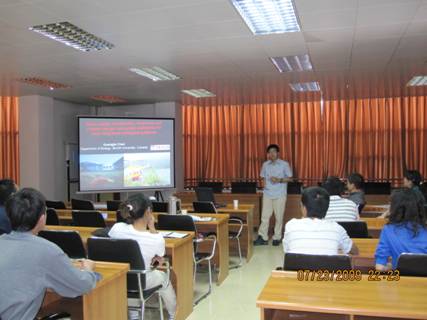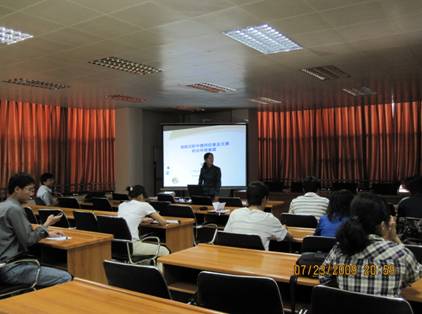On 24 July 2009, at the invitation of Prof. Z. P. Lai, McGill University Dr. Guangjie Chen and NIGL Dr. Fengqin Chang gave lectures respectively on Water quality, biodiversity, food web and climate change: using lake sediments to track long-term ecological patterns and Paleo-environment reconstruction of isotopic and elemental strontium in lake sediments, to the ISL audience.

Dr. Chen mainly focuses on studies of lacustrine ecological systems and environments. He addressed three issues in his report: (1) Reconstruction of past biocoenosis by means of paleolimnological methodology and indirect reconstruction of biological nutrient levels by conversion functions: building the conversion functions for modern lakes based on multi-index analysis whereby the relations between paleolimnological biocoenosis and hydrochemistry can be studied; (2) The population pattern of salmons was found based on long-term systematic investigations in the Pacific Ocean: studying the spawning density of salmons by means of δ15N tracing and the influences of the interactions of food webs on the ecological system of salmons based on multi-index sedimentary analysis; (3) The significance of lacustrine sedimentology and recent research scopes, methods and approaches were also addressed.

Dr. Chang mainly focuses on studies of environmental significance of lacustrine isotopes. In her report, she addressed the study on the variations of testaceous Sr isotopes and elemental ratios at Ejina Banner and Qaidam Basin by combining AMS 14C chronology and analysis of the environmental significance of biological testaceous Sr isotopes in various carriers. It is believed that the climate of Qaidam and Ejina Basins had been warm and humid during the MIS3 stage and there had existed high lake levels and periods of expanded lakes, which is comparable to other regions. The varying ranges and fluctuation amplitudes of Sr isotopes indicate the difference of the climates of the two basins, and meanwhile reflect the influences of weathering processes of river basins and biological activity on microenvironments. It was pointed out that Sr/Ca ratios have excellent precision in indicating lake salinity, hence better representing the changes of water environments.
|

